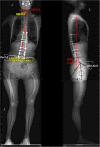A case report of severe degenerative lumbar scoliosis associated with windswept lower limb deformity
- PMID: 32883265
- PMCID: PMC7470442
- DOI: 10.1186/s12893-020-00857-x
A case report of severe degenerative lumbar scoliosis associated with windswept lower limb deformity
Abstract
Background: The windswept lower limb deformity describes valgus deformity in one leg with varus deformity in the other. It is mostly seen in young children with metabolic bone diseases (such as rickets) and may lead to leg length discrepancy (LLD) and Degenerative scoliosis (DS) in older age. To the best of our knowledge, there was no report of the spinal surgery in patient with severe DS associated with windswept deformity. The objective of this study is to report the unique case of a 60-year-old woman with severe degenerative scoliosis (DS) associated with windswept deformity caused by rickets who underwent a posterior correction and fusion surgery in spine.
Case presentation: The patient was diagnosed as rickets windswept lower limb deformity for 50 years but never went through routine treatment. Then, she performed lumbar scoliosis for more than 20 years and suffered from severe back pain for 4 years. After overall clinical evaluation and radiographic measures, we performed a posterior surgical correction and fusion from T9-L5. With this surgery, the main thoracolumbar curve Cobb angle corrected from 72.5° to 21.0°, the coronal balance from 0 cm to 2.0 cm while the sagittal vertical axis (SVA) from 1.5 cm to - 1.0 cm. At 2 years postoperative follow-up, her back pain has almost completely relieved with a satisfied fixation and bone fusion showed on CT scans. However, a coronal imbalance was found with C7-CSVLdistance equal to 4.0 cm. This coronal imbalance was highly correlated to the untreated LLD and pelvic obliquity, and should be improved by standing posture or shoe lifts.
Conclusions: For such patient, the pure spinal correction and fusion surgery, in spite of lower limbs deformity, can achieve good relieve of back pain symptom, however may accompany by the complication of coronal imbalance due to the unimproved pelvic obliquity and LLD. However, longer follow-up is necessary to observe the long-term outcome of this patient's postoperative coronal imbalance.
Keywords: Degenerative scoliosis; Leg length discrepancy; Pelvic obliquity; Rickets; Windswept lower limb deformity.
Conflict of interest statement
The authors declare that they have no competing interests.
Figures



Similar articles
-
Utility of multilevel lateral interbody fusion of the thoracolumbar coronal curve apex in adult deformity surgery in combination with open posterior instrumentation and L5-S1 interbody fusion: a case-matched evaluation of 32 patients.J Neurosurg Spine. 2017 Feb;26(2):208-219. doi: 10.3171/2016.8.SPINE151543. Epub 2016 Oct 21. J Neurosurg Spine. 2017. PMID: 27767682
-
Factors influencing radiographic and clinical outcomes in adult scoliosis surgery: a study of 448 European patients.Eur Spine J. 2016 Feb;25(2):532-48. doi: 10.1007/s00586-015-3898-x. Epub 2015 Apr 28. Eur Spine J. 2016. PMID: 25917822
-
Posterior corrective surgery with a multilevel transforaminal lumbar interbody fusion and a rod rotation maneuver for patients with degenerative lumbar kyphoscoliosis.J Neurosurg Spine. 2017 Feb;26(2):150-157. doi: 10.3171/2016.7.SPINE16172. Epub 2016 Oct 7. J Neurosurg Spine. 2017. PMID: 27716016
-
Correlation of radiographic, clinical, and patient assessment of shoulder balance following fusion versus nonfusion of the proximal thoracic curve in adolescent idiopathic scoliosis.Spine (Phila Pa 1976). 2002 Sep 15;27(18):2013-20. doi: 10.1097/00007632-200209150-00009. Spine (Phila Pa 1976). 2002. PMID: 12634561 Review.
-
Survival of patients with Duchenne muscular dystrophy who underwent spinal deformity correction.Dev Med Child Neurol. 2024 Feb;66(2):187-194. doi: 10.1111/dmcn.15711. Epub 2023 Jul 21. Dev Med Child Neurol. 2024. PMID: 37482906 Review.
References
Publication types
MeSH terms
Grants and funding
LinkOut - more resources
Full Text Sources
Medical
Miscellaneous

